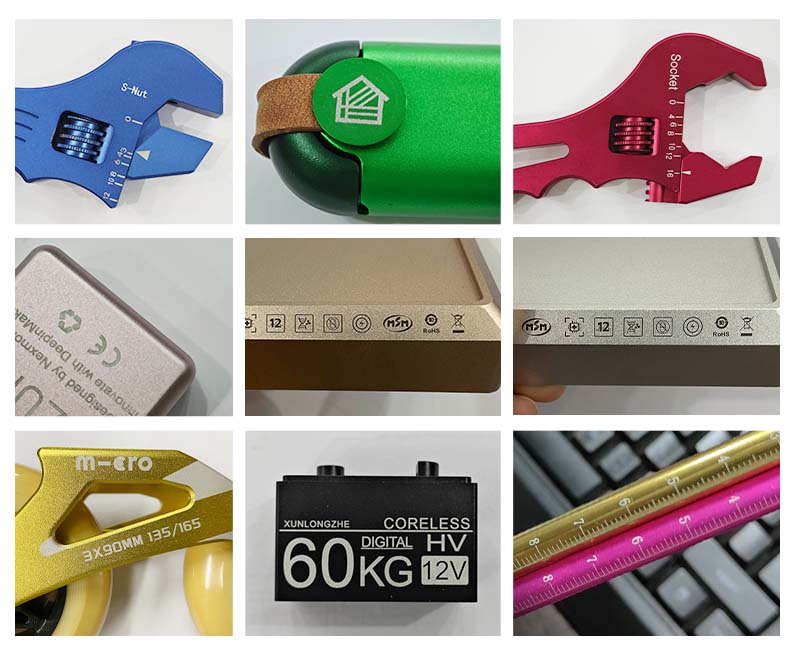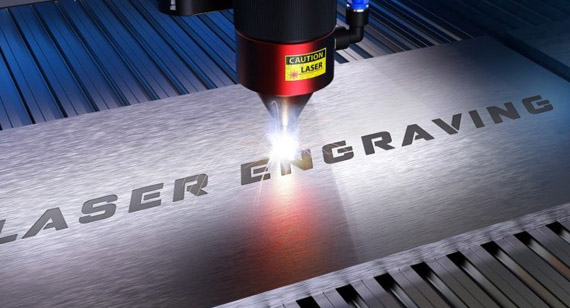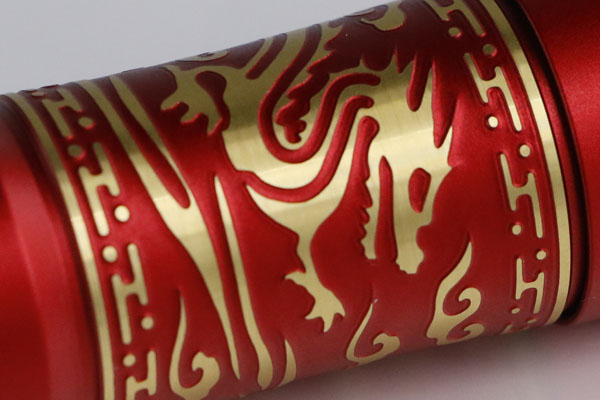15 years one-stop China custom CNC machining parts factory
 177 |
Published by VMT at Nov 14 2024 | Reading Time:About 4 minutes
177 |
Published by VMT at Nov 14 2024 | Reading Time:About 4 minutes
Are you struggling to find the most efficient method to mark or customize your aluminum CNC machining parts? Frustrated by traditional techniques that don't provide the precision or durability your custom CNC machining projects demand? You're not alone. Many manufacturers face challenges in achieving high-quality, permanent markings on metal surfaces. But what if laser etching could be the game-changing solution your CNC machining plant needs to elevate your products and services?
Laser etching is a non-contact, versatile method that uses concentrated laser beams to create precise, permanent markings on various materials, including aluminum. It offers unmatched accuracy, speed, and durability, making it an ideal choice for marking aluminum CNC machining parts in custom CNC machining and CNC prototype machining services.
Now that we've highlighted how laser etching can revolutionize your CNC machining services, let's delve deeper into what laser etching is, how it works, and why it's the go-to solution for marking aluminum and other materials in the manufacturing industry.
Preface
In today's competitive manufacturing landscape, the ability to produce high-quality, customized parts efficiently is paramount. CNC machining services have evolved to meet these demands, but the need for precise and permanent part marking remains a critical aspect of production. Laser etching has emerged as a leading technology in this area, offering unparalleled precision, speed, and versatility. This comprehensive guide will explore laser etching in depth, focusing on its applications in aluminum etching and how it enhances the capabilities of custom CNC machining and CNC prototype machining services.

What Is Laser Etching?
Laser etching is a subset of laser marking techniques that involves using a high-powered laser beam to alter the surface properties of a material to create a visible mark. Unlike engraving, which removes material to create deep cuts, laser etching melts the surface layer, causing it to expand and form a raised mark. This process changes the reflectivity and enhances the contrast of the material's surface, making the etched design or text stand out clearly.
The laser etching process is highly controlled and precise, allowing for the creation of intricate designs, logos, serial numbers, barcodes, and other markings essential for identification, branding, and traceability. The non-contact nature of laser etching means there is minimal mechanical stress on the material, preserving the integrity and functionality of the part.
Laser etching is compatible with a wide range of materials, including metals like aluminum, steel, and titanium, as well as plastics, ceramics, and glass. In the context of aluminum CNC machining parts, laser etching provides a durable and high-contrast marking solution that withstands harsh environmental conditions without degrading over time.
Aluminum is one of the most commonly used materials in CNC machining due to its excellent strength-to-weight ratio, corrosion resistance, and machinability. Aluminum CNC machining parts are prevalent in industries such as aerospace, automotive, electronics, and medical devices. Marking these parts effectively is crucial for identification, compliance, and branding purposes. Laser etching offers an ideal solution for aluminum etching, providing high-quality, permanent markings that complement the precision of custom CNC machining services.

Aluminum etching refers to the process of creating designs, text, or patterns on aluminum surfaces through chemical or physical means. Traditional methods include chemical etching using acids or alkaline solutions, which can be hazardous, time-consuming, and less precise. Laser etching, on the other hand, uses focused laser beams to alter the aluminum surface without the need for chemicals or physical contact.
In laser etching of aluminum, the laser beam rapidly heats the surface, causing localized melting and vaporization. This process results in a slight deformation or discoloration, creating a visible mark with high contrast against the surrounding material. The laser parameters can be adjusted to achieve different effects, such as varying depths, textures, and shades.
Laser etching on aluminum offers several advantages:
For CNC machining plants specializing in aluminum CNC machining parts, integrating laser etching into the production process enhances product value and meets industry demands for quality and traceability.
Laser etching is a versatile process applicable to a wide array of materials used in manufacturing. The compatibility of laser etching with various substrates makes it an indispensable tool in CNC machining services. Materials that can be effectively laser etched include:
The ability to laser etch such a diverse range of materials allows manufacturers to apply consistent marking techniques across different components, streamlining production processes. In custom CNC machining and CNC prototype machining, laser etching provides flexibility to mark parts made from various materials without the need for multiple marking systems.

Understanding the laser etching process is essential for manufacturers aiming to implement this technology effectively. The process involves several steps, from design preparation to the actual etching and finishing of the part. Familiarity with the process enables CNC machining plants to optimize parameters, improve efficiency, and achieve the desired marking quality on aluminum CNC machining parts and other materials.
The laser etching process involves using a laser machine to project a concentrated beam of light onto the surface of a material, altering its appearance to create a visible mark. The key components of the process include:
The laser's energy causes localized heating, melting, or vaporization of the material's surface, resulting in a mark that can be seen and felt. The process is controlled by computer numerical control (CNC) systems, ensuring high precision and repeatability, which is essential for CNC machining services.
How to Etch Aluminum Plates with Simple Steps?
Etching aluminum plates can be accomplished using laser etching, which offers a straightforward and efficient method suitable for both prototyping and production. Below is a step-by-step guide on how to etch aluminum plates, integrating the process into your custom CNC machining workflow.
Prepared Materials
Before beginning the etching process, gather all necessary materials and equipment to ensure a smooth operation.
Given that laser etching does not require chemicals or transfer sheets, the process is simplified and more environmentally friendly.
Step: 1 - Create Design and Prepare the Laser Machine
Develop your design using CAD or graphic design software compatible with your laser etching machine. Ensure the design is saved in the correct format (e.g., DXF, AI, or SVG) and adjust the scale to fit your aluminum panel.
Set up the laser machine by:
Step: 2 - Prepare and Clean Aluminum
Clean the aluminum panel thoroughly using a solvent like isopropyl alcohol to remove any oils, dirt, or residues. This step ensures optimal laser interaction with the surface and prevents imperfections in the etching.
Secure the aluminum panel on the laser machine's worktable using clamps or fixtures to prevent movement during etching.
Step: 3 - Execute Laser Etching
Start the laser etching process by initiating the machine's operation through the control software. Monitor the process to ensure the laser is etching accurately according to the design.
Key considerations during etching:
Step: 4 - Inspect and Clean the Etched Aluminum
After the etching process is complete, carefully remove the aluminum panel from the machine. Inspect the etching for clarity, depth, and accuracy against the design specifications.
Clean the etched panel with water or a mild solvent to remove any debris or residue. Dry it thoroughly to prevent water spots or corrosion.
Step: 5 - Finish and Protect the Panel
Depending on the application, you may apply a protective coating or paint to enhance the appearance and longevity of the etched design. Options include:
By following these steps, you can efficiently integrate laser etching into your aluminum CNC machining parts production, enhancing the value and functionality of your products.
Choosing the right laser machine is crucial for achieving optimal results in laser etching. Various types of laser machines are suitable for different materials and applications. For aluminum etching, certain laser technologies offer advantages in terms of efficiency, precision, and compatibility with CNC machining services.
Fiber Laser
Fiber lasers are among the most popular choices for metal etching, including aluminum. They utilize a doped fiber as the laser medium and produce a wavelength of approximately 1064 nm, which is highly effective for metal absorption.
Advantages of Fiber Lasers for Aluminum Etching:
Fiber lasers are well-suited for CNC machining plants focused on high-volume production and intricate designs on aluminum CNC machining parts.
CO2 Laser
CO2 lasers use a gas mixture as the laser medium and emit a wavelength of around 10.6 micrometers. They are versatile and commonly used for non-metal materials, but with certain configurations, they can etch metals like aluminum.
Considerations for CO2 Lasers:
CO2 lasers can be an option for CNC prototype machining where versatility is needed across different materials.
Diode Laser
Diode lasers are compact and energy-efficient, emitting wavelengths suitable for certain marking applications. However, their lower power output makes them less effective for direct metal etching without assistance.
Limitations with Aluminum Etching:
Diode lasers are not typically recommended for aluminum etching in professional CNC machining services.
Infrared Laser
Infrared lasers encompass fiber lasers and other types emitting in the infrared spectrum. They are effective for metal processing due to their absorption characteristics.
Benefits for Aluminum Etching:
Selecting an appropriate infrared laser system depends on specific requirements such as power, precision, and production volume in your CNC machining plant.
While laser etching and laser engraving are often used interchangeably, they are distinct processes with different outcomes. Understanding the differences is essential for selecting the appropriate method for your aluminum CNC machining parts and ensuring the desired results in custom CNC machining services.

Depth of Cut
The depth affects the durability and appearance of the marking. Laser engraving is suitable when deeper, more tactile markings are required, whereas laser etching is ideal for surface-level markings with high contrast.
Material Hardness
For aluminum, both methods are applicable, but laser etching offers faster processing with less impact on the material's integrity.
Formation
The choice between the two depends on the desired visual effect and functional requirements of the marking.
Durability
In environments where parts are subject to mechanical wear or harsh conditions, laser engraving may be preferable.
Production Volume
For CNC machining plants focused on efficiency and large-scale production of aluminum CNC machining parts, laser etching is advantageous.
Cost
Budget considerations may influence the choice between the two methods in custom CNC machining services.
Laser etching is utilized across various industries for applications that require precise, permanent markings. Some common applications include:
In the context of aluminum CNC machining parts, laser etching adds value by providing essential markings without compromising the part's functionality or appearance.
Successful implementation of laser etching requires careful consideration of various factors that influence the quality, efficiency, and cost-effectiveness of the process. Understanding these factors helps CNC machining plants optimize their laser etching operations for aluminum CNC machining parts and other applications.
Complexity
The complexity of the design affects the laser etching process in terms of time and precision. Intricate designs with fine details require precise laser control and may increase processing time. It's important to:
Cost
Factors influencing the cost of laser etching include:
Balancing cost with desired outcomes is essential for profitability in custom CNC machining services.
Design
Effective laser etching relies on well-prepared designs. Considerations include:
Time
Processing time impacts production schedules and costs. Factors affecting time include:
Efficient scheduling and parameter optimization help meet deadlines in CNC prototype machining and production runs.
Material
Material properties influence laser etching outcomes. Consider:
Understanding material behavior ensures consistent results in CNC machining services.
Accuracy
Achieving high accuracy in laser etching is crucial for functional and aesthetic purposes. Factors influencing accuracy include:
Investing in quality equipment and training enhances accuracy in laser etching operations.
Selecting laser etching for marking aluminum CNC machining parts offers numerous benefits:
For CNC machining plants aiming to provide comprehensive services, integrating laser etching enhances the value proposition to clients seeking custom CNC machining and CNC prototype machining solutions.
Laser etching stands as a transformative technology in the manufacturing industry, offering precision, efficiency, and versatility unmatched by traditional marking methods. For aluminum CNC machining parts, laser etching provides a permanent, high-quality solution that complements the precision of custom CNC machining services. By understanding the laser etching process, materials compatibility, and factors influencing success, manufacturers can optimize their operations and deliver superior products.
Whether you operate a CNC machining plant or specialize in CNC prototype machining, incorporating laser etching into your services can set you apart in a competitive market. Embracing this technology not only enhances product quality but also streamlines production processes, leading to increased customer satisfaction and business growth.
Is Laser Etching Permanent?
Yes, laser etching is a permanent marking method. It alters the material's surface, creating marks that are resistant to wear, corrosion, fading, and environmental factors. This permanence makes laser etching ideal for parts requiring long-lasting identification, such as serial numbers, barcodes, and branding on aluminum CNC machining parts.
How Deep Can Laser Etch?
Laser etching typically affects the surface layer of the material, with depths ranging from 0.0001 to 0.001 inches (0.0025 to 0.025 mm). The exact depth can be controlled by adjusting laser parameters such as power, speed, and focus. For deeper marks, laser engraving is used, which can reach depths of 0.005 inches (0.127 mm) or more.
What Colors Can Lasers Etch?
Laser etching itself does not add color to the material but can create contrast by altering the surface's appearance. On metals like aluminum, laser etching can produce shades ranging from light gray to dark gray or black, depending on the laser settings and material properties. Some lasers can induce color changes through controlled oxidation, allowing for a range of colors on certain metals.
How Accurate Is Laser Etching?
Laser etching is highly accurate, capable of achieving tolerances as tight as ±0.001 inches (±0.025 mm). The precision is influenced by factors such as machine calibration, laser quality, and operator expertise. This high level of accuracy makes laser etching suitable for intricate designs and small components in CNC machining services.
How Fast Is Laser Etching?
Laser etching is a rapid process, with marking speeds ranging from a few inches per second to over 100 inches per second, depending on the laser type, material, and complexity of the design. The speed allows for high-volume production without compromising quality, enhancing efficiency in CNC machining plants.
What Types of Lasers Can Perform Laser Etching?
Common types of lasers used for etching include:
Nd
Lasers: Suitable for both metals and non-metals, offering flexibility.
UV Lasers: Used for fine marking on sensitive materials like plastics and glass.
The choice depends on the material and specific application in custom CNC machining services.
What Is the Price of a Laser Etching Machine?
The price of a laser etching machine varies widely based on factors such as laser type, power, size, and features. Entry-level machines suitable for small-scale operations may start around $5,000, while industrial-grade fiber laser systems for metal etching can range from $30,000 to over $100,000. Investing in a high-quality machine ensures reliability and performance in CNC machining services.
What Makes Some Lasers More Expensive?
Factors contributing to higher costs include:
Consider these factors when selecting equipment for your CNC machining plant.
What Is the Difference Between Laser Etching and Laser Marking?
Laser marking is a broad term encompassing various methods, including laser etching, engraving, and annealing. Laser etching specifically refers to altering the material's surface to create a raised mark, while laser marking can also include:
Understanding these differences helps in selecting the appropriate method for your application in CNC prototype machining and production.
